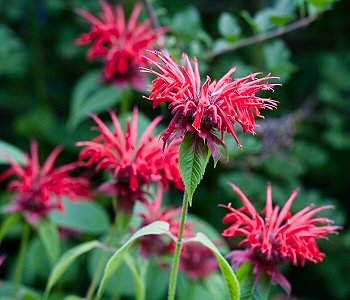
|
|
Monarda
- Red Bergamot (Monarda didyma)
|
Monarda - Bee balm -
Bergamot - Monarda spp.
Monarda (bee balm, horsemint, oswego tea, or bergamot) is a genus consisting of roughly 16 species of
erect, herbaceous, annual or perennial plants in the family Lamiaceae. The genus is endemic to North
America. Ranging in height from 1 to 3 feet (0.2 to 0.9 m), the plants have an equal
spread, with slender and long-tapering (lanceolate) leaves. The leaves are opposite on the
stem, smooth to sparsely hairy, with lightly serrated margins, and rangeing from 3 to 6 inches (7 to 14 cm) in
length. In all species, the leaves, when crushed, exude a spicy, highly fragrant
oil. Of the species examined in one study, M. didyma (Oswego Tea) was found to contain the highest concentration of this
oil.
The genus was named for Nicolas Monardes who wrote a book in 1574 describing plants found in the New World.
Monarda species include annual and perennial upright growing herbaceous plants with lanceolate to ovate shaped
leaves. The flowers are tubular with bilateral symmetry and bilabiate; with upper lips narrow and the lower ones broader and spreading or
deflexed. The flowers are single or in some cultivated forms double, generally hermaphroditic with two
stamens. Plants bloom in mid- to late summer and the flowers are produced in dense profusion at the ends of the stem
and/or in the stem axils. The flowers typically are crowded into head-like clusters with leafy
bracts. Flower colors vary, with wild forms of the plant having crimson-red to
red, pink and light purple hues. M. didyma has bright, carmine red blossoms; M.
fistulosa—the "true" wild bergamot—has smokey pink flowers. M. citriodora and M. pectinata have light lavender to
lilac-colored blooms and have slightly decreased flower quantities. Both species are commonly referred to as
"Lemon Mint." There are over 50 commercial cultivars and hybrids, ranging in color from
candy-apple red to pure white to deep blue, but these plants tend to be smaller than wild
species, and often developed to combat climatic or pest conditions. Other hybrids have been developed to produce essential oils for
food, flavoring, or medicine. "M. didyma" species can grow up to 6 feet
tall. Seed collected from hybrids—as with most hybridized plants—does not produce identical plants to the
parent. A number of hybrids also occur in the wild.
The plants are widespread across North America and can be found in moist
meadows, hillsides, and forest clearings up to 5,000 feet in elevation.
Bee balm is considered a good plant to grow with
tomatoes, ostensibly improving both health and flavor. It also is a good companion plant in
general, attracting pollinators and some predatory/parasitic insects that hunt garden
pests.
Although somewhat bitter, due to the thymol content in the leaves and
buds, the plant tastes like a mix of spearmint and peppermint with oregano. Bee balm was traditionally used by Native Americans as a seasoning for wild
game, particularly birds. Edible Parts of Monarda. Leaves and young shoot tips - raw or
cooked. They are used as a flavouring in salads, fruit salads, drinks etc.
Flowers - raw. They are added as an attractive garnish to salads. An excellent aromatic tea is made from the fresh or dried leaves and flower
heads. The leaves give an Earl Grey flavour to China tea.
Early European colonists learned to use the plant from the Oswego
Indians, who crushed its leaves for an impromptu poultice to soothe pain from insect
stings. Made into a mild tea—Oswego tea—the leaves eased indigestion.
In 1773, colonists rebelling against England’s excessive taxes crept onto English ships and dumped a fortune in English tea into the
harbor. The Boston Tea Party’s rowdiness led promptly to empty teacups, until colonists discovered Oswego
tea.
Several bee balm species (Monarda fistulosa and Monarda
didyma) have a long history of use as a medicinal plants by many Native Americans including the
Blackfoot, Menominee, Ojibwa and Winnebago. The Blackfoot Indians recognized the strong antiseptic action of these
plants, and used poultices of the plant for skin infections and minor wounds. A tea made from the plant was also used to treat mouth and throat infections caused by dental caries and
gingivitis. Bee balm is the natural source of the antiseptic Thymol, the primary active ingredient in modern commercial mouthwash
formulas. The Winnebago used a tea made from bee balm as a general stimulant. Bee balm was also used as a carminative herb by Native Americans to treat excessive
flatulence. An infusion of crushed Monarda leaves in boiling water has been used to treat headaches and
fevers.
Monarda yields an essential oil, used in
perfumery, as a hair tonic etc. The dried leaves and flowers are used to scent and add colour to
pot-pourri.
Source:
http://en.wikipedia.org/wiki/Monarda
http://www.pfaf.org/user/Plant.aspx?LatinName=Monarda%20didyma
http://www.herbcompanion.com/Gardening/Make-Friends-with-Monarda.aspx?page=2
